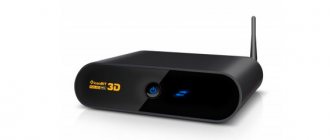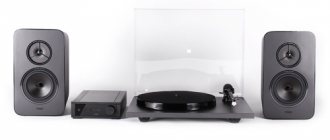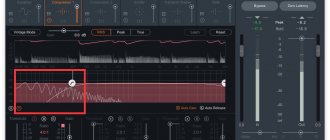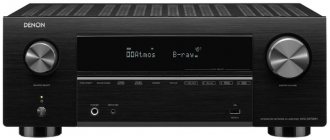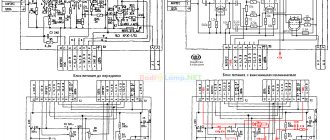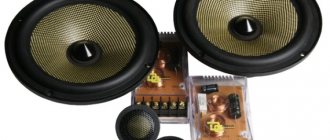Bowers&Wilkins Diamond 803 D3. Diamond edges of pure sound, review. Portal "Soundex.ru"
The triumph of Bowers&Wilkins high technology is evident. The Diamond 803 D3 speakers are amazing. These are real virtuoso performers, absolutely free from any genre preferences.
Save and read later -
There has long been a lot of debate about Bowers&Wilkins acoustic systems among lovers of good sound. However, they have no doubts about the sound quality of the flagship Bowers&Wilkins 800 series, which has been produced since the late 70s of the 20th century and is a conscious choice for many audiophiles. The last update to the “diamond” version of this series took place in 2015. We decided to test, in every sense, the completely new Bowers&Wilkins 803 D3 speakers from the legendary line.
At first glance, the Bowers&Wilkins Diamond 803 D3 three-way speakers look like a designer's delight. But this is only the first impression. In fact, everything here is subject to pure physics with the main goal - to achieve maximum sound quality. As the famous Soviet aircraft designer Andrei Nikolaevich Tupolev argued, an ugly plane will not fly. Bowers&Wilkins proves that this is true for loudspeakers as well.
Each of the speaker strips has a separate, mechanically isolated housing. Only two surfaces of the woofer (the bottom and the sloping top panel) are flat. All other surfaces are curved to one degree or another, which reduces their area, increases structural rigidity, and minimizes internal reflections and diffraction of sound waves. The acoustic design of the bass is a bass reflex. Instead of Marlan composite material, the new 800s actively use aircraft-grade aluminum. The mid-frequency housing with anti-resonance fins (Turbine Head technology) is made from this material. The body of the high-frequency diamond tweeter is also made of aluminum and has a non-hollow design (Solid Body Tweeter). These changes made it possible to practically eliminate the resonances of the midrange and high-frequency cabinets. The rear wall of the low-frequency cabinet, also made of aircraft aluminum, serves as an excellent heat sink for the crossover, and makes the external design of these speakers more expensive and complete.
All speakers in the new 800 Series Diamond are available in three finishes: piano black, matte white or pink walnut. In all options, the finish looks simply great. The body responds to tapping in an extremely dull manner, while vibrations are practically not transmitted to the drivers.
Midrange/bass speakers can be covered with complete grilles, separate for midrange and bass. The dimensions of the 803 D3 are typical of modern floorstanding speakers above the mid-range price range.
A special element of the housing design is a massive metal base, into which non-removable rollers are mounted, making it easy to move these heavy speakers around the room during the setup process. In a stationary position, twist-out spikes with magnetic covers are used to protect the floor from damage, which are also already built into the base. The manufacturer strongly recommends listening to the speakers mounted on spikes.
The speakers are equipped with high-quality output terminals that allow the use of all types of connectors, both bare wire and spade/banana. It is possible to connect speakers in bi-wiring/bi-amping modes. To parallelize the LF/MF/HF outputs, wire jumpers with high-quality spade/banana connectors are provided.
Technologies
800 Series Diamond is the flagship speaker series from Bowers&Wilkins. Naturally, the newest, best technologies and developments that the company has are used here.
The first and most sensational change is that KEVLAR is NO LONGER USED in the midrange speakers! For eight years, work has been carried out at the research center in Steyning to create a new, more advanced material for the speaker cone. And here is the result - Continuum. Like Kevlar, it is also a woven composite, providing a clearly controlled first resonance. The design of the Continuum diffuser is based on the concept of optimized and controlled flexibility. It helps avoid the abrupt transition from piston-like behavior to resonant behavior, which greatly degrades the openness and neutrality of the sound of conventional speakers. The Continuum midrange drivers also feature Cone's traditional Fixed Suspension Transducer (FST) technology, which significantly reduces response time and keeps intermodulation distortion to a minimum.
Traditionally, when producing diffusers for low-frequency drivers, Bowers&Wilkins provides for their execution in the form of a sandwich of two layers of carbon, between which there is a layer of foamed polymer. The new speakers in the series use AeroFoil technology. The Aerofoil diffuser profile comes to us from the aircraft industry (another reference to a “beautiful airplane”). In aerodynamics, an aerofoil profile is defined by its chord length, a straight line drawn between the leading and trailing edges of the wing. The Aerofoil profile uses a continuously varying thickness of material that provides maximum stiffness exactly where you need it.
AeroFoil diffusers allow for higher structural rigidity with low weight. Thanks to the optimal distribution of rigidity along the generatrix of the diffuser, its piston mode of operation is ensured, which allows for correct bass reproduction.
The low-frequency driver housings have increased thickness walls and a complex internal strut structure (Matrix technology). The Matrix technology itself has also undergone changes. Now there are fewer stiffening ribs, but instead of 10 mm hardboard, the material used is 19 mm plywood reinforced along the front of the AC with aluminum ties. This ensures maximum overall rigidity and effectively dissipates internal reflections.
The bass reflex ports are made using patented FlowPort technology, which provides a variable cross-section with a grooved channel surface. This ensures better consistency with the parameters of the drivers and cabinet, and also avoids the appearance of overtones when the acoustics are operating.
Anti-Resonance Plug technology (a protective cone cap with a damping insert) provides consistently wide sound dispersion throughout the mid-frequency range. A special feature of the Diamond 803 D3 model is the mechanical decoupling of the midrange driver from the Turbine Head housing, which, in turn, is mechanically decoupled from the bass and treble driver housings. Due to this, additional stabilization of the position of the mid/high frequency drivers in space was achieved.
Diamond tweeter domes are manufactured using high-temperature chemical carbon deposition. The unique combination of diamond properties makes the dome both light and extremely rigid, which guarantees piston operation of the dome up to 70 kHz. The driver's optimized magnetic system increases sensitivity by 2 dB over the standard design, reducing driver power consumption by approximately 40%. Reducing the signal power, in turn, reduces the heating of the voice coil and the sound compression associated with this heating. The HF driver, mounted in a durable metal housing, is mechanically decoupled from it (Solid Body Tweeter technology).
Sound quality Bowers&Wilkins Diamond 803 D3
The acoustic systems passed the first stage of testing (assessment using the AudioDoctor FSQ 2006 method). They produce a lively and transparent sound, which is characterized by: tonal balance and good accuracy, excellent “joining” of the mids with the top. The subjectively perceived bass turned out to be very deep and at the same time very detailed. A wide and continuous stereo base on test recordings does not extend beyond the speakers. The stage is deep and well layered. The drum is perceived somewhat closer to the double bass, which corresponds to the recording conditions. The space and air of the stage are conveyed well, as is the movement of the vocalist from the back of the stage to the microphone located in the foreground (track 12).
Focusing and localization in the horizontal plane is excellent, in the vertical plane it is very good. The height of the instruments is almost identical to the natural height. Sound images are not associated with speakers. The sound at low levels is natural, the timbres of the instruments are reliable.
Microdynamics - excellent. Macrodynamics are good; at high volume levels, dynamic contrasts are somewhat smoothed out. Attack is excellent.
The big Turkish drum recorded on track 14 is very natural. The push to the chest is weighty and visible, but not harsh. It is clearly felt that the sound came from below, where the instrument was located during recording.
Next, to evaluate the sound of the 803 D3, the following test CDs were played:
- DALI CD. In Admiration of Music. Volumes 1-4
- Various Artists - The TBM Sounds! (UltraHD 32bit CD), LIM UHD 048
- B&W Presents: Very Audiophile New Recordings
- B&W Maria Callas Remastered, The Complete Studio Recordings (1949-1969)
- SOUND CHECK 2 Audio Test
- Alan Parsons SOUND CHECK 2 Audio Test and Demonstration CD
.
Diamond 803 D3 confidently play any music without any expressed preferences. Chamber compositions, BSO, Big Band, opera, jazz, rock - everything sounds beautiful, very tasty, and most importantly, accurate. The timbres of instruments and voices are reliable. The after-sounds are natural and extended in time. When listening for a long time, you don’t feel tired at all, but rather get involved in the music. The sound stage is built behind the speaker line. It is continuous, evenly filled, deep and well echeloned. Apparent sound sources are realistically displayed in the recording space at almost life-size. The speakers create a sound field in which they themselves are practically invisible. Macro and microdynamics are more than sufficient. The attack is good on all recordings.
The 803 D3 speakers made it possible to hear in detail all the characteristic features of well-known tracks.
Human voices and instruments recorded in near-field without post-processing from the Alan Parsons SOUND CHECK 2 Audio Test and Demonstartion CD sounded very natural, with all the richness of detail characteristic of live performance. At times the sound could easily be confused with live.
The organ on track 86 “Bach's Toccata and Fugue in D minor” appeared before us in all its power and beauty. As the musical action developed, the sound moved freely between the registers of the instrument, both horizontally and vertically, and the speakers managed to preserve the characteristic pre- and post-sounds of the organ.
Also, with the help of the Diamond 803 D3, we were able to confidently distinguish many differences in the mastering of the tracks on the B&W Maria Callas Remastered (1949-1969), The Complete Studio Recordings disc. The imperfections and defects characteristic of old archival recordings dissolved and faded into the background, giving us the opportunity to enjoy great music and the singer’s magical voice. On the last three tracks, originally recorded in stereo, Callas even went ahead, beyond the speaker line.
The strongest impression was made by the Wheel of Fortune theme from Hans Zimmer from the film “Pirates of the Caribbean” (track 9, DALI CD. In Admiration of Music. Volume 4). The orchestra, with all its violins, oboes and horns, literally came to life in the recording space. Powerful bass lines were felt physically, literally with the whole body. The Diamond 803 D3 were able to display a huge amount of spatial information in this area of the audio range. To say we haven't heard it before would be a lie. But perhaps this is the first time we have heard it so clearly. Moreover, the sound invariably remained transparent at all volume levels.
The Diamond 803 D3 speakers can be called moderately sensitive to room placement. For excellent sound, you just need to fulfill the basic placement requirements.
conclusions
The triumph of Bowers&Wilkins high technology is evident. The Diamond 803 D3 speakers are amazing. These are true virtuoso performers, absolutely free from any genre preferences.
This is definitely not a cheap model, but still, its cost cannot be called exorbitant. Therefore, if desired, it is quite affordable, especially since the listening pleasure and excellent quality correlate very well with the price of the speakers.
Prepared based on materials from the portal “Soundex.ru”, February 2016
www.news.soundex.ru
This review was read 9,594 times
B&W 803 Diamond speaker test
B&W has updated its flagship 800 line. This time the numbers are complemented by the most precious stone - the diamond, and for good reason. The 800 Diamond series uses it in the tweeter design.
Advantages
- Amazingly tuned sound
— Solid appearance
Flaws
- Sounds distant at low volumes
Improvements have affected almost every component of the speakers from the updated series, but it is the diamond tweeters that take the sound quality to a new level. It was not for nothing that B&W designers chose the most radical material in terms of rigidity. For this purpose, a special technology has been developed, where a layer of diamond crystals is packed between a metal substrate, on which it is gas deposited and covered with a protective coating. In addition to the dome, the new tweeter has a new magnetic system of four powerful magnets. The damping tube on the rear side and the outer tweeter housing remain the same. The oval casing of the speaker is made of plywood, 35 mm thick. It is reinforced from the inside by a system of intersecting powerful bulkheads (Matrix), which evenly fill the entire internal space of the hull. Thanks to this, box overtones are significantly reduced. For midrange drivers, B&W traditionally uses Kevlar cones with rigid FST suspension made of synthetic foam. The diffusers of the bass speakers, and there are three of them in the column, are made of a three-layer composite Rohacell. And their double magnet improves response and minimizes distortion. The crossover is also seriously simplified. The small bass reflex port, located on the front wall, is traditionally covered with small recesses that reduce air flow turbulence. The sound of the new 803s is large, dynamic, with a dense, solid bass, elastic as a ball, with crystal clear highs and very realistic mids. The scene is so prominently three-dimensional that it is simply impossible not to pay attention to it. The resolution of these speakers is absolutely phenomenal, both sound and music. Indeed, the new diamond tweeter cannot be called anything other than a decoration for the 800 series speakers from B&W. Together with the Kevlar midrange driver, the diamond tweeter is responsible for constructing a holographically accurate scene, pauses and other time, read semantic aspects that are so rarely constants. 803ya has all this in its arsenal. De facto. With such abilities it can stand in the studio as a monitor. What alarmed me: sometimes a light veil is heard. Not in the voice, but above it. I think it will warm up and everything will pass. And further. At medium volume, a certain arrogance and detachment from what is happening appears, which dissolves when you unscrew the volume knob. Naturally, clockwise. Generally speaking, it’s not often that you come across such a strong and charismatic speaker that she can handle anything. I see no reason not to confess my love to her. I think that I will not be alone in this feeling.
The frequency response graph behaves best in the bass and mid frequencies. In this section, the frequency response changes smoothly and within small limits. Stronger unevenness is seen at high frequencies. But, despite this, the imbalance in the frequency response is minimal. The THD of the speakers is very low, especially if you listen to them at high volumes. The lower the volume, the more the THD increases. This is especially noticeable at low frequencies - distortion begins to increase from 60 Hz, but it still happens quite slowly. The impedance is not ideal, but an amplifier of the appropriate class will easily cope with such a load.
Text: Alexander Knyazev, Nikolai Balandin
